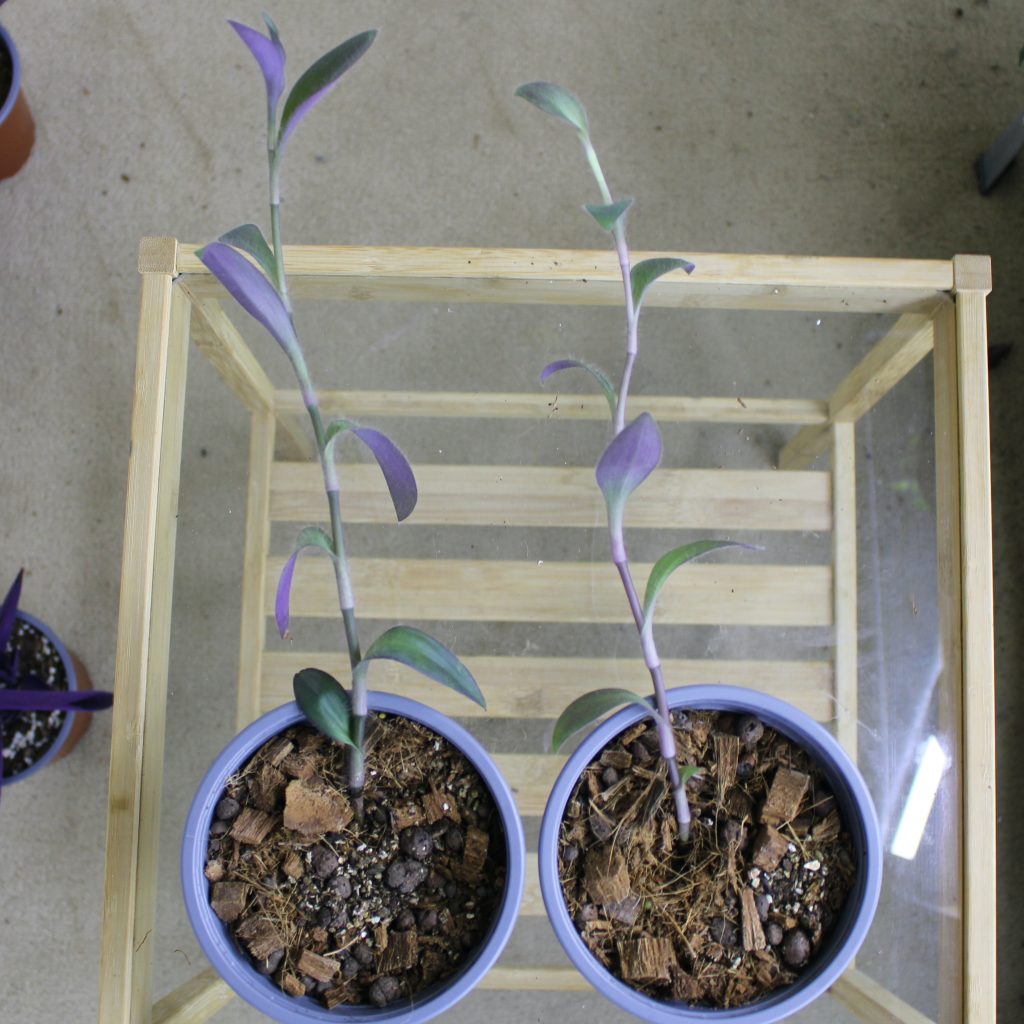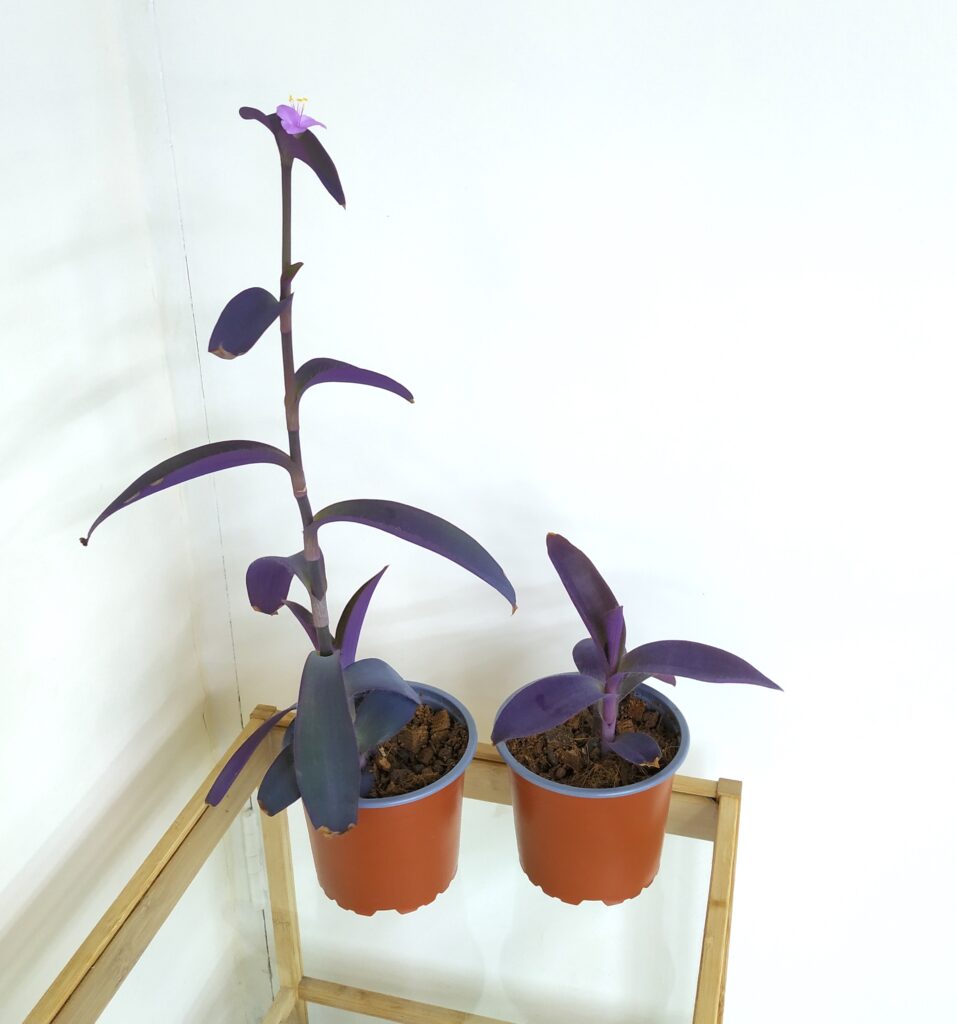Skip to: History // Comparisons // Conclusions // References
(This article was updated on 4th April 2022, to include the registered name of the new cultivar, ‘Purple Pixie’.)
Tradescantia pallida ‘Purpurea’, often called by its synonym ‘Purple Heart’, has been popular for decades. It’s a big and vigorous sprawling plant, with strong purple leaves and stems. People often use it for hanging baskets, summer ground cover, and as a houseplant.
If you pay close attention, you might have noticed that some plants labelled as ‘Purple Heart’ seem different to others. And that’s because there are actually two different widespread forms of purple T. pallida that are often labelled the same way. In this article I’ll explain their history, then the growth trials I did to compare the two, and finally make some conclusions.
History
The older plant was first named as Setcreasea purpurea by Boom (1955). The description was based on a plant found growing in a botanical garden in Darmstadt, which had been collected from Central or North America some time at the beginning of the century.

The genus Setcreasea has since been combined with Tradescantia. And the plant Boom described is now considered a synonym for the species T. pallida. So the particular purple form that originated at that botanical garden is now treated as a cultivar of that species, under its original name ‘Purpurea’.
Since then it’s also been given various synonyms, including ‘Purple Queen’ (Vaughan, 1960, p20), ‘Purple Heart’ (Martorell et al., 1981, p24), and ‘Purple Sabre’.
The “other” type seemed to appear much more recently, and had no valid cultivar name for a while. It has now (as of 4th April 2022) been registered with the name ‘Purple Pixie’.

It’s often distributed with the name ‘Purple Passion’ and/or ‘Purple Heart’. The earliest source I’ve found is a 2018 blog post with a photo of the plant and the tag, but it was probably around for a few years before that. It’s commercially produced by Gj Hendriks CV, from original stock which they got from PT Florion, a wholesaler in Indonesia.
In Europe, the two are sometimes distinguished by labelling the old cultivar Setcreasea purpurea and the newer type T. pallida ‘Purple Heart’. Even though those two names are actually synonyms! In the UK and USA they aren’t usually distinguished at all.
Note: There’s also a third purple cultivar of T. pallida, which is a bit less widespread, which goes by the names ‘Kartuz Giant’, ‘Biltmore Bimbo’, and ‘Big Bertha’. That plant is distinctive because of its extremely wide leaves – so wide that they develop pleats where they meet the stem. I’m not considering that cultivar in this article because it’s not commonly mistaken for the others.
Comparisons
‘Purpurea’ and ‘Purple Pixie’ are certainly quite similar plants. But they do have differences which are consistent and objectively apparent, even when grown in identical conditions. After growing the two plants together for a year, in varying conditions and through repeated propagation, it was very obvious they were distinct.
So I did some more precise trials to document their differences objectively. I grew the plants side by side, from identical small cuttings, in three different conditions:
- Low light. Set well back from any windows, with no artificial light.
- Standard light. In a southwest-facing windowsill during summer in the UK.
- Extreme light. With the top of the foliage 5cm away from an 11W, 6500K LED spotlight.
In all cases I watered them once the soil was mostly dry.
After about three months, I measured and documented the differences between the plants in all conditions. They showed their characteristics slightly differently in each case, but in all cases they had objectively measurable differences.
After those trials to measure shape and size, I also compared their exact colours when grown under standard light.
Low light
Both cultivars became extremely leggy and pale in low light conditions – they really didn’t like it! But even so, there are differences between them.

At a glance they look pretty similar, although the stems of ‘Purple Pixie’ seem much more pinkish than the darker green ‘Purpurea’.
Examining individual leaves shows the measurable differences much more clearly.

The leaves are a completely different shape. In ‘Purpurea’, they’re about 65mm long and 18mm wide. Whereas in ‘Purple Pixie’, they’re about 50mm long and 22mm wide.
For any numbers nerds, we can turn those into a single length:width ratio of 3.6 for ‘Purpurea’ and 2.3 for ‘Purple Pixie’.
The stem length between leaves is about 35mm for both types, so not a good way to distinguish them in low light conditions.
Standard light
Both cultivars looked healthy in this condition – it seems to be just right for them.

Here, one of the most dramatic differences is obvious. ‘Purpurea’ grows much more vigorously than ‘Purple Pixie’. These started off with cuttings of the same size, from healthy stock plants. And the ‘Purpurea’ has grown three times the size in the same amount of time! It also started flowering enthusiastically, which ‘Purple Pixie’ has yet to do in the eighteen months I’ve been growing it – not even larger stock plants.
Checking out the leaves again, we can see the same shape difference as the low light condition.

The leaves of ‘Purpurea’ are about 135mm long and 36mm wide. In ‘Purple Pixie’, they’re about 100mm long and 43mm wide.
That gives length:width ratios of 3.8 for ‘Purpurea’ and 2.3 for ‘Purple Pixie’. Interestingly, although the leaves are much bigger in both cultivars when grown in standard light, the shape of the leaves is almost exactly the same. It seems to be a very good way to distinguish them even when grown in varying conditions.
In this condition, they also show much clearer differences in their stems.

They both have much thicker stems than in low light. But while ‘Purpurea’ stems are slightly longer at about 45mm between leaves, the stems of ‘Purple Pixie’ are much more compact. The spacing between leaves was about 20mm, so closely-packed that the leaf sheaths overlapped all the way along the stem.
Extreme light
With extreme light stress, both cultivars became slightly stunted and grew more slowly overall – but their colours were even more dramatic.

It’s not quite as dramatic as in standard light, but ‘Purpurea’ still grew a bit quicker, and flowered too.

Once again, they have the same difference in leaf shape. ‘Purpurea’ leaves are about 120mm long and 42mm wide, whereas ‘Purple Pixie’ has leaves about 85mm long and 49mm wide.
That gives length:width ratios of 2.9 for ‘Purpurea’ and 1.7 for ‘Purple Pixie’. Under this extreme light stress, they both developed comparatively shorter leaves, but still with a dramatic difference between them.
They also both had extremely compact stems in this condition. I had to remove the leaves to be able to actually measure the internode length.

‘Purpurea’ has internode lengths ranging from about 8 to 25mm, whereas ‘Purple Pixie’ was even shorter – never more than 5mm.
Colours
It’s difficult to portray colours accurately in photos. But there are noticeable colour differences between the two cultivars. So I’ll try to describe them qualitatively, as well as refer to colour chart values (RHS, 2019). All of these descriptions apply to the plants when grown in what I call standard light conditions, like a sunny UK windowsill – common houseplant conditions.
The upper surface of ‘Purpurea’ leaves is slightly less saturated, ranging from dark purplish grey (N186A) to dark greyish green (N189A). ‘Purple Pixie’ is very similar, but just slightly brighter – ranging from dark purplish grey (N186A) to dark greyish purple (N186B), but never so greenish.

The underside of the leaves is similarly a bit lower in saturation for ‘Purpurea’, from dark purple (79B) to greyish purple (N187B), and becoming greyish yellow green (191A) where they meet the stem. Whereas the leaf undersides of ‘Purple Pixie’ are dark purple (79B), becoming strong purple (77B) where they meet the stem.
On ‘Purpurea’ stems range from dark greyish green (N189A) to dark purplish grey (N186A). Whereas on ‘Purple Pixie’, they’re always greyish purple (N77A).
Overall, the best way to summarise the colour differences are that ‘Purpurea’ is more greenish and grey, whereas ‘Purple Pixie’ is more pinkish or red. But the differences are subtle, and probably not the easiest way to distinguish them.
So what’s the difference?
In conclusion, here are the most obvious characteristics which distinguish the two cultivars.
- Leaf shape. The leaves of ‘Purpurea’ are longer and thinner, always at least 2.5x as long as they are wide. In comparison the leaves of ‘Purple Pixie’ are shorter and wider, always less than 2.5x as long as they are wide.
- Growth habit. ‘Purpurea’ grows much more quickly, generally with longer stems, and is much quicker to flower. ‘Purple Pixie’ has much more compact and slow growth, and rarely flowers.
- Colours. ‘Purpurea’ has a slightly more green or grey tone overall, whereas ‘Purple Pixie’ is brighter with pink or red shades. The best place to see these differences is to look at the underside of the leaves where they wrap around the stem.
The older cultivar is a bit more common in most places. Its correct name is Tradescantia pallida ‘Purpurea’, even though it’s often referred to with any of various synonyms, like ‘Purple Heart’ and ‘Purple Queen’.
The newer type is a bit less widespread, mainly because of its slow growth – it takes longer before people can start distributing cuttings! Its correct name is Tradescantia pallida ‘Purple Pixie’, but it often gets incorrectly labelled as ‘Purple Heart’ (a synonym for ‘Purpurea’) or ‘Purple Passion’ (a totally different cultivar that already exists).
References
Boom, B. K. (1955). NOTES ON CULTIVATED PLANTS. Acta Botanica Neerlandica, 4(2), 167–171. doi:10.1111/j.1438-8677.1955.tb00325.x. Open access link.
Vaughan’s Seed Company. (1960). Foliage Plants and Snaps [Brochure]. Open access link.
Martorell, L. F., Liogier, A. H., Woodbury, R. O. (1981). Catalogo de los Nombres Vulgares Y Cientificos de las Plantas de Puerto Rico. Universidad de Puerto Rico. Open access link.
RHS Media (2019). RHS Colour Chart.


2 replies on “The other ‘Purple Heart’”
I suggest the new plant subtype be called ‘Overlapping Leaf Sheaths Purpurea’, because that’s the way it’s easiest for me to distinguish the two. I am in the Twin Cities, Minnesota and for $4 USA I just bought a 4″ pot of the newer type, and that’s how I stumbled on your website. (I belong to a FB group called Twin Cities Houseplant Circle.) I have a question for you: I’ve been excited about how I’ve just learned to make my own sphagnum moss poles (I use dried tree branches, easily found after rain storms, and wrap them – so far I’ve made a 3′ pole for a monstera, and two mini-poles of apprx. 1 1/2 inch, one of which I’m trying with one of my small purple princess trandescantia, and the other which is a plant that a somewhat-similar light-brown’ish color, – long-‘thin’-oval leaves and its’ leaves are fuzzy (I can ask my group what the name of that one is). Have you written about using moss poles with trandescantia plants?? I’m trying it, as one way to help it get more light to all the leaves, plus also I’d love a plush plant that climbs the pole (or is cascading actually better for trandescantia plants???).
I’ve never written about using moss poles, because I’ve never tried it myself. I remember seeing one or two people post photos of their moss pole tradescantias but I don’t have any good resources for you I’m afraid. I’m sure it wouldn’t do any harm to the plant though, as long as it has water and nutrients it won’t really mind what shape it grows in. Good luck with your experiment!